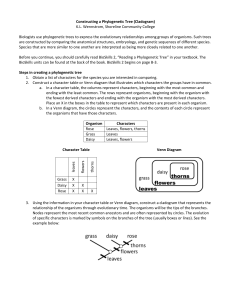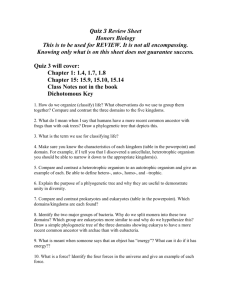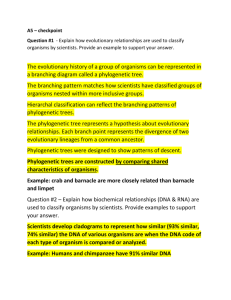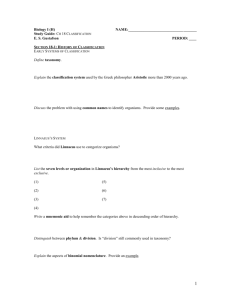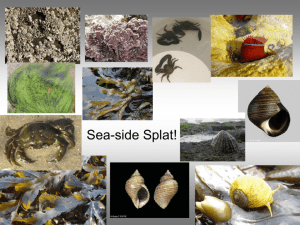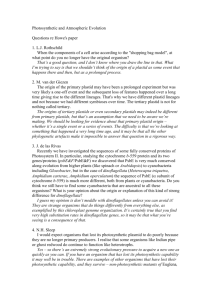Quiz 2 Review Sheet
advertisement
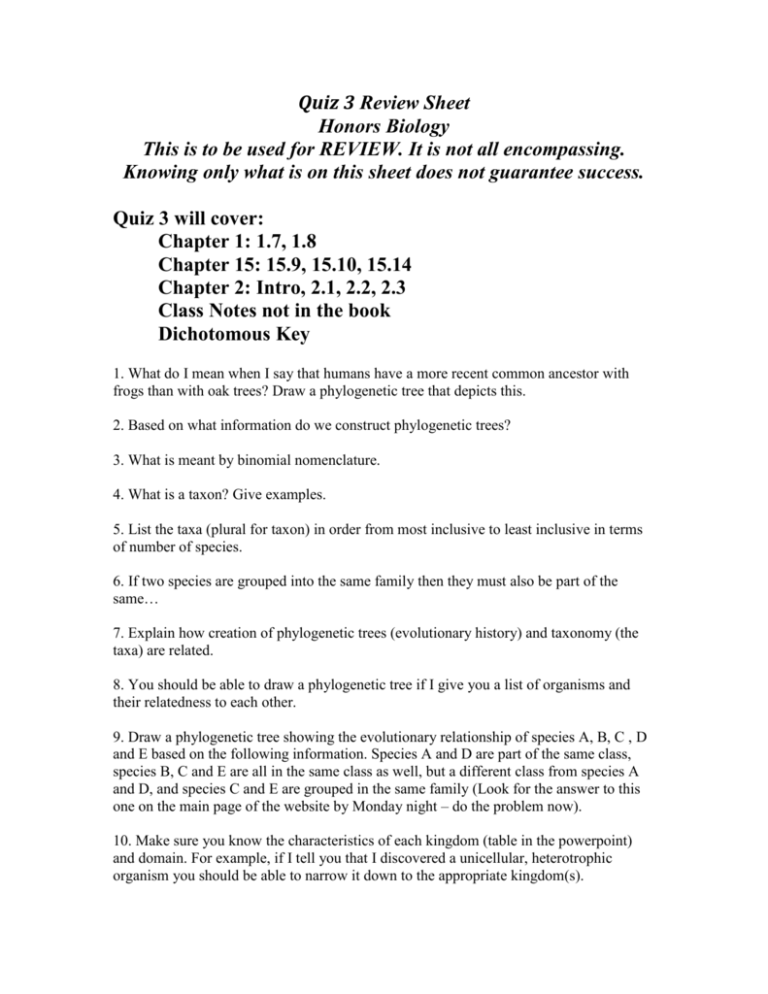
Quiz 3 Review Sheet Honors Biology This is to be used for REVIEW. It is not all encompassing. Knowing only what is on this sheet does not guarantee success. Quiz 3 will cover: Chapter 1: 1.7, 1.8 Chapter 15: 15.9, 15.10, 15.14 Chapter 2: Intro, 2.1, 2.2, 2.3 Class Notes not in the book Dichotomous Key 1. What do I mean when I say that humans have a more recent common ancestor with frogs than with oak trees? Draw a phylogenetic tree that depicts this. 2. Based on what information do we construct phylogenetic trees? 3. What is meant by binomial nomenclature. 4. What is a taxon? Give examples. 5. List the taxa (plural for taxon) in order from most inclusive to least inclusive in terms of number of species. 6. If two species are grouped into the same family then they must also be part of the same… 7. Explain how creation of phylogenetic trees (evolutionary history) and taxonomy (the taxa) are related. 8. You should be able to draw a phylogenetic tree if I give you a list of organisms and their relatedness to each other. 9. Draw a phylogenetic tree showing the evolutionary relationship of species A, B, C , D and E based on the following information. Species A and D are part of the same class, species B, C and E are all in the same class as well, but a different class from species A and D, and species C and E are grouped in the same family (Look for the answer to this one on the main page of the website by Monday night – do the problem now). 10. Make sure you know the characteristics of each kingdom (table in the powerpoint) and domain. For example, if I tell you that I discovered a unicellular, heterotrophic organism you should be able to narrow it down to the appropriate kingdom(s). 11. Compare and contrast a heterotrophic organism to an autotrophic organism and give an example of each. Be able to define hetero-, auto-, homo-, and –trophic. 12. Explain the purpose of a phlyogenetic tree and why they are useful to demonstrate unity in diversity. 13. Compare and contrast prokaryotes and eukaryotes (table in the powerpoint). In which domains/kingdoms are each found? 14. Identify the two major groups of bacteria. Why do we split monera into these two domains? Which group are eukaryotes more similar to and why do we hypothesize this? Draw a simple phylogenetic tree of the three domains showing eukarya to have a more recent common ancestor with archae than with eubacteria. 15. You should be able to identify an organisms genus and species using a dichotomous key as well as write a simple dichotomous key to identify a number of species similar to the lab. 16. Be able to explain in detail Figure 1.7A in terms of energy flow and cycling of chemical nutrients (food web). 17. Explain why we said that energy flows (one-way). Describe, starting from the sun, the flow of energy to Earth and away from Earth. 18. In class we briefly spoke about global warming and it being caused by the greenhouse effect. Explain how the greenhouse effect works and identify whether this effect is positive or negative to our existence on this planet. 19. Describe what is meant when we say that chemical nutrients cycle between the abiotic and the biotic. Give specific examples of nutrients cycling. You will be asked to describe how an atom somewhere could end up somewhere else as we did in class (i.e. a carbon in me could find itself being part of your great, great grandkids a hundred years from now). 20. Explain the role of decomposers in an ecosystem using figure 1.7A. 21. Read the intro of chapter 2, there will be one question. 22. Explain figure 2.1 in terms of structure-function relationships and emergent properties. 23. Compare the holistic to the reductionist approach to science. 24. What is matter? 25. Define what an atom is. What does “atom” mean in Greek and why is this appropriate. 26. What is an element? (Two similar definitions) 27. How many elements are known? How many occur naturally? How many are found in organisms (are essential to life)? 28. Be familiar with the table in section 2.2. Identify the top four major elements of life. Be familiar with the other seven elements below those. 29. What is meant by a trace element? Give an example that demonstrates the importance of these elements even though we only need them in small amounts. 30. If you didn’t use the goiter as your example in #37, identify what a goiter is and how one would develop such a disease. 31. What is a compound? 32. Compare an element to a compound and give examples of each. 33. Explain elements like oxygen and nitrogen exist in the atmosphere. 34. Explain how emergent properties apply when going from element to compound. Give an example. 35. Study tip: When you think you know what you need to know, go through the assigned book sections, cover the section with a piece of paper except for the heading and try to explain to yourself what the section says. Make sure you hit all the bolds words and figures/tables. Your are most likely ready if you can teach the material to someone else. Addendum: Make sure you know the nine animal phyla in order (use the mneumonic) and an example organism or group of organisms belonging to each.

